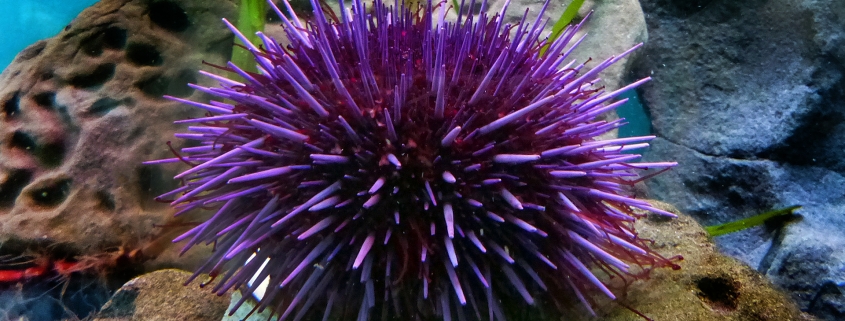Authors: Emma Grigg & Nastja Kharine
Common Name: Purple Sea Urchin.
Scientific Name: Strongylocentrotus purpuratus
Size range: up to 15 cm (6 inches) across.
Identifying Features: As in its name, the Purple Sea Urchin is purple but it can also be a purplish green colour. The Purple Sea Urchin is a medium sized sea urchin compared to its relatives the Green and Red Sea Urchin, measuring up to 15 centimeters across. It has a circular body covered in heavy spines. These spines cover the entire crust-like body acting as protective armor.
Habitat: Purple Sea Urchins are found from the coast of Alaska to the north of Mexico. They live in water up to about 160cm (63inches) deep on rocky coastlines. They use their spines to dig holes in pebbles, sand and rock to create a protective groove. These grooves are their homes and they shelter the urchins from crashing waves. Purple sea urchins like living with their friends and family, so you can usually find them in groups.
Food: The Purple Sea Urchin eats mostly algae. It has teeth that help it pull algae off rocks. They are also known to eat plankton, kelp, periwinkles, barnacles, mussels, dead fish and sea sponges.
Predators: Many things eat Purple Sea Urchins, even though they have huge spines. Crabs, sunflower stars, snails, sea otters, some birds, fish and people like Purple Sea Urchins on their menus.
Life Cycle: Purple Sea Urchins usually live up to 30 years or longer. They breed around January to March every year. The female sea urchins can produce up to twenty million eggs in one year. When the female sea urchins lay their eggs, the young urchins start off as larvae. It takes a few months for the larvae to develop into small baby sea urchins. It takes 2-5 years before a new sea urchin can reproduce.


